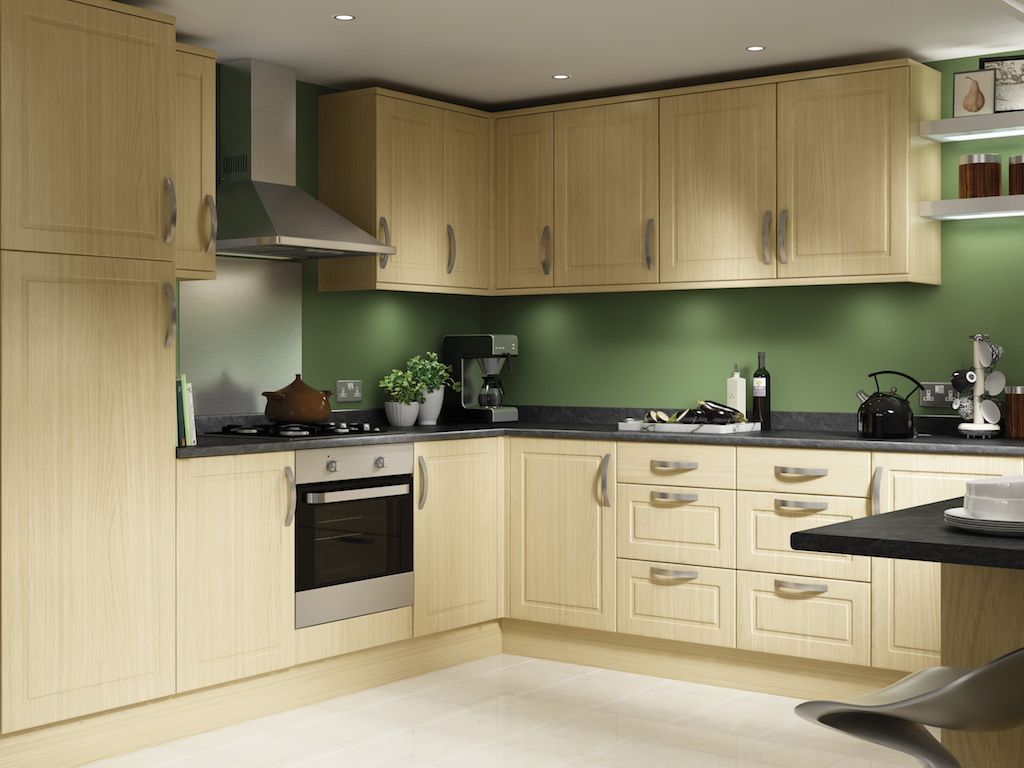
Affordable housing is experiencing an unprecedented level of change as the need to be able to offer a diverse range of tenures builds. As a result, local councils and housing associations are looking to suppliers that will offer up-to-date, long-lasting solutions without comprising on quality. Neil McDonald offers advice.
Kitchens that are designed with longevity in mind are far more likely to appeal to housing associations as they offer a sustainable, long-term solution that makes the most of squeezed budgets. Well-made kitchens — such as Moores’ cabinets, which are glued, dowelled and then squared and set in a high-pressure press — require less maintenance and will last for many years, even with a potential high turnover of residents.
Special features to help future-proof a kitchen’s lifespan include a timeless design that can evolve, hard-working materials, and the robust backing of a guarantee. This is why Moores only specifies high quality, hardwearing door and carcase materials along with premium accessories such as Blum hinges. These are elements that reduce the need for replacements caused by the wear and tear of ‘cheaper’ solutions that ended up becoming costlier in the long-term. Sophisticated manufacturers will subtly integrate these features so that residents can enjoy an attractive space in their home with the extra design touches housing associations expect today.
FIRA accreditation
There is an increasing importance for those working in the public sector to specify products that help meet a combination of strict industry sustainability codes, budgets and designs. A simple way to ensure a manufacturer is producing high quality and sustainable product choices is to look out for brands and products that are FSC and FIRA accredited. Moores for example holds FSC certification and many of our kitchens come with the FIRA Gold award, which recognises both high product quality and design and environmental performance. This means the housing associations can rest assured that they are choosing a product that has passed rigorous testing procedures, such as ergonomic assessment and structural performance, and is also kind to the environment.
Provide flexibility between tenures
The ability to differentiate between affordable rent, market rent, shared ownership and for sale is key. This is why many manufacturers have a good, better, and best brand structure, which enables tenures to be kept distinct from each other. The Moores Affinity range (good) offers choice and style with mass appeal and is ideal for rented tenures. Definitive (better) brings a stylish designer look that can work well in shared ownership and market sale properties.

Green credentials
There are a number of ways a kitchen can be classed as sustainable — from material choices, through to manufacturing processes and the supply chain. Companies that use locally sourced materials and manufacture the entire kitchen on site reduce the product’s carbon footprint, eliminating the need for long transportation processes. For example, we use a number of UK based suppliers close to our factory in Wetherby, as well as a manufacturing process that is set up to optimise material and reduce waste.
A sustainable supply chain solution does not have to mean a compromise on overall product production, performance or design. Some kitchens in our Affinity collection for affordable homes use MFC (Melamine Faced Chipboard) doors. The MFC contains a high proportion of recycled material including our own chipboard waste, which is sent back to the manufacturer for recycling. The end result is a stylish but sustainable product solution that appeals to both the residents and the developer with minimal wastage. Affinity is our flagship range for affordable homes and has stylish, mass appeal for local councils.

Embrace open plan living
The desire for open plan living is spilling over into local authority design, especially as more households become multigenerational. And with that in mind, multigenerational occupiers should be a serious consideration for housing association developers. Patchwork families, intercultural communities, and multi-generational households are changing traditional models. The modern style is characterised by less conventional forms of cohabitation as well as a more conscious approach to the environment.
Reasons for multigenerational cohabitation can vary — from the rising cost of mortgages to grandparents opting to downsize. Overall, we are seeing that the traditional floorplan is changing in favour of more ‘community zone’ layouts with versatile living spaces.
With the growing trend for open-plan kitchens, a minimalist, sleek style is now important in the home. Make sure you incorporate plenty of storage solutions into the overall kitchen design to ensure clutter can be removed from the worktops and hidden away. A simple but effective design, in keeping with the rest of the home, ensures an efficient workflow and a beautifully stylish room.
We are also seeing a rise in ‘broken plan living’ in which distinct areas can be created by the use of different floor finishes, differences in floor levels and floating freestanding partitions, such as bookcases or a screen. This means that it is still possible to achieve the spacious feel that open-plan living provides, but creates a separation so that people can have their own space away from each other.









